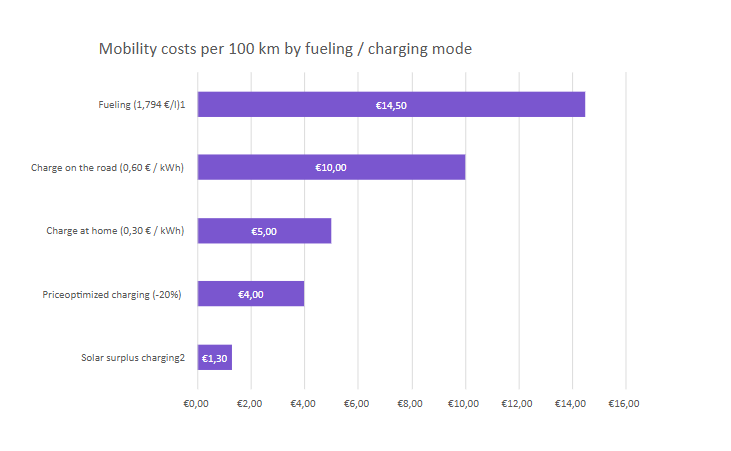BEV or PHEV? Discover the differences, benefits, and which electric vehicle fits your driving style. A compact guide – perfect for beginners.
Is your old car spending more time at the shop than at home? Are you about to move into your long-awaited countryside home? Is your family growing? There are many reasons to start thinking about a new vehicle - and it’s a great opportunity to consider alternative drivetrains.
That’s when people start asking themselves: which type of electric vehicle is right for me? In Germany, two types of electric drivetrains are particularly relevant: Battery Electric Vehicles (BEVs) and Plug-in Hybrid Electric Vehicles (PHEVs). Both have their strengths and drawbacks. But what exactly sets them apart? And which fits your lifestyle better?
If you're new to the world of e-mobility, terms like BEV (Battery Electric Vehicle) and PHEV (Plug-in Hybrid Electric Vehicle) can be confusing. This article breaks down the key differences between the two: how they work, how they charge, and what that means for your day-to-day driving. Whether you're in the market for an EV or simply exploring your options, this is a quick and easy guide to understanding electric vehicles.
Market overview: BEV vs. PHEV in Germany
In 2024, a total of 2.8 million passenger vehicles were newly registered in Germany. Of these, 380,609 were BEVs (13.5% market share) and 191,905 were PHEVs (6.8% market share). Together, plug-in vehicles accounted for 20.3% of all new registrations.
What Is a BEV (Battery Electric Vehicle)?
A BEV runs solely on electricity stored in a large battery. It has no internal combustion engine, making it locally emission-free and exceptionally quiet. Ranges vary by model and driving style but often exceed 300 km. BEVs don’t require fuel stops, but do need to recharge regularly at a charging station.
Advantages:
- 100% electric with zero local CO₂ emissions (depending on energy mix)
- No oil changes required
- Low operating costs
- Expanding charging infrastructure
Disadvantages:
- Longer charging times compared to refueling
- Reduced range, especially in winter
What Is a PHEV (Plug-in Hybrid Electric Vehicle)?
A PHEV combines an electric motor and rechargeable battery with a traditional internal combustion engine. The electric motor covers short distances emission-free, while the combustion engine supports longer trips or higher speeds. Like BEVs, PHEVs can be charged at home or at public charging stations.
Advantages:
- Greater flexibility and extended range thanks to combustion engine
- Low energy consumption in electric mode
- Well-suited for commuters with short daily trips and access to charging
Disadvantages:
- Higher CO₂ emissions compared to BEVs (approx. 40 g CO₂/km)
- More complex and heavier due to dual drivetrains
- Higher purchase price and maintenance effort
Which model best fits your needs?
A BEV is ideal for:
Short, regular trips with predictable charging opportunities
Drivers with access to reliable charging infrastructure (e.g., at home or at work)
Those who value zero emissions and low operating costs
A PHEV makes sense for:
Longer journeys where regular charging is challenging
Drivers who want the flexibility to switch between electric and combustion power
Hybrid drivers looking for a gradual transition to full e-mobility
Smart e-mobility: solar panels, home chargers & more
If you're considering purchasing an electric vehicle, it's also worth evaluating your home energy setup. Transitioning to e-mobility presents a great opportunity to reduce long-term costs and gain independence from the energy grid by investing in a solar panels and a home charger.
Charging your BEV or PHEV with your own solar power is not only more sustainable, it’s also significantly cheaper. When combined with a home battery storage system, you can maximize the use of your own surplus solar energy and enjoy flexible charging times. These synergies make e-mobility particularly efficient compared to conventional fossil-fuel-based drivetrains.

Why now is the right time to go electric
E-mobility is growing rapidly in Germany. In 2024, a record 99.3 GW of installed solar capacity was achieve, an increase of 16.2 GW from the previous year. One-third of these new installations were residential solar power systems. In July 2024 alone, solar power production peaked at 8.7 TWh.
Meanwhile, CO₂ pricing is rising: starting January 2025, the CO₂ price for gasoline will be €55 per ton - equivalent to roughly 15.7 cents per liter. This makes fuel more expensive and further incentivizes switching to electric.
Conclusion
Whether BEV or PHEV, both drivetrains have their place. The best choice depends on your individual needs, driving habits, and access to charging infrastructure. For longer distances or limited access to charging, a PHEV can be a practical transitional solution. However, for mostly short trips and regular access to charging, a BEV offers the most environmentally friendly, cost-effective, and future-proof option.
Sources:
Germany: BEV market share at 13,5% | European Alternative Fuels ObservatoryProduction and market in December 2024 | VDA
CC_MVSA0388-CC-Briefing-Paper-Hybrids-vs.-BEVS_V3-FA-Screen-Single-1.pdf
Zusammenfassung_TCO-Studie_deutsch_final.pdf
Pkw und leichte Nutzfahrzeuge | Umweltbundesamt
